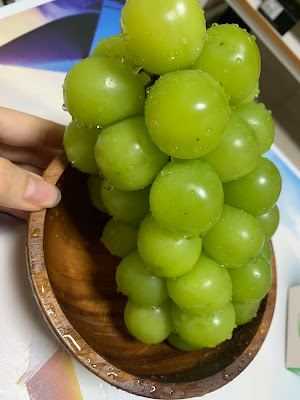Welcome to Korea!
Korea has four distinct seasons: spring, summer, fall, and winter.
Each season brings its own seasonal fruits, and they taste best when eaten at the right time. Let me recommend some of these fruits to you!
My English might not be perfect, but I hope you’ll find it cute!
Cherry tomatoes, unlike regular tomatoes, are small enough to pop into your mouth in one bite. Although they're technically a vegetable, they're often eaten like a fruit, and you can enjoy them with the skin on. They're great as a healthy snack and perfect for anyone on a diet.
Since cherry tomatoes can be grown in greenhouses, they are available all year round. However, they are in season during the summer, which is when they're the cheapest.

During strawberry season, there are many desserts made with strawberries. Cafes also sell delicious strawberry smoothies. I highly recommend trying one!
2. Strawberry
Korean strawberries are much sweeter and more flavorful compared to foreign ones. They come in both small and large sizes. If you're visiting Korea during strawberry season, it's a must-try fruit!
In Korea, the main strawberry season is from March to June, with April and May being the peak months when they are the sweetest and most flavorful. During this time, strawberries are known for their perfect balance of sweetness and freshness, and many people enjoy them.
However, thanks to greenhouse farming technology, strawberries are also available in winter, though they can be relatively expensive.

During strawberry season, there are many desserts made with strawberries. Cafes also sell delicious strawberry smoothies. I highly recommend trying one!
During strawberry season, you can find delicious strawberries at supermarkets and local markets, not just department stores. While convenience stores do sell them, I wouldn't recommend buying from there because they tend to be overpriced. Koreans typically don't buy fruit from convenience stores.
3. Orange
Oranges are typically in season from winter to spring in Korea, with the peak season being from November to April. During this time, oranges are at their best, with plenty of juice, a fresh, sweet flavor, and a rich taste. The optimal time to enjoy oranges is between December and February.
4. Shine Muscat Grape
The peak season for Shine Muscat grapes is typically from summer to fall, with the main season being from August to October. During this time, Shine Muscat grapes are at their sweetest, juiciest, and freshest. September and October are the best months to enjoy them, as the quality is at its peak.
These grapes are incredibly sweet, so if you're not a fan of overly sweet flavors, they might not be for you. However, they're one of the favorite snacks for kids! The best part is, you can eat them with the skin on, making them super convenient and easy to enjoy.
Since summer is the peak season for Shine Muscat grapes, you'll find them everywhere at supermarkets and markets during this time.

5. Banana
Bananas are just easy to snack on, so I thought I'd mention them. The taste is nothing different from what you'd expect from a banana.
6. Chamoe (Korean Melon)
Chamoe (Korean melon) is in season during the summer, with the peak season typically from June to August. Of course, chamoe is available starting in May. You can commonly find it at markets or supermarkets.
During this time, chamoe is at its sweetest, juiciest, and freshest. July and August are especially the best months to enjoy a chamoe, as the quality is at its highest, and it’s perfect for refreshing yourself with its cool, sweet taste during the summer heat.
If you find chamoe in Korea, definitely give it a try!
7. Pear (Baemul)
The peak season for Korean pears is in the fall, typically from September to November. During this time, pears are at their sweetest, juiciest, and most flavorful. September and October are the best months to enjoy pears, as this is the harvest season.
I recently saw a foreigner on YouTube almost eat a pear with the skin on. But you absolutely have to peel the skin off before eating a pear! That’s the only way to enjoy the cool, sweet flesh inside. (And don’t eat the seeds!)

8. citrus fruits( Hallabong, Gyul (Mandarin Orange))
Both Hallabong and Gyul are in season during the winter, but their peak times are slightly different: Gyul (mandarin oranges) are typically in season from November to January, while Hallabong is at its best from January to March.
If you’re visiting Korea in the winter, make sure to try these fruits from a local market or grocery store. Just peel the skin and you’ll find sweet, juicy flesh inside. They’re seedless and super easy to eat, even in your hotel room!
Hallabong is more expensive than gyul (mandarin oranges), but it’s also sweeter and more fragrant. It’s mainly grown on Jeju Island and is a fruit that nearly every Korean loves.
If you visit Korea, make sure to try the local fruits! But I don’t recommend buying them from department stores or convenience stores — they’re usually overpriced.
If you want to buy fruit, visit places like E-Mart, NewCore Outlet, or Homeplus.
These are popular supermarkets that locals use. They also sell snacks that are great as souvenirs or for munching, so it’s worth stopping by!
If you’re looking for a fruit knife or everyday household items,
I recommend visiting Daiso.
It’s a popular store among Koreans these days, known for its super affordable prices and surprisingly good quality.
💗If you have any other questions, don’t hesitate to drop a comment below!💗
If you want to learn more about Korea,
click on the 'South Korea Seoul Trip' label on this blog.😆






















Comments
Post a Comment